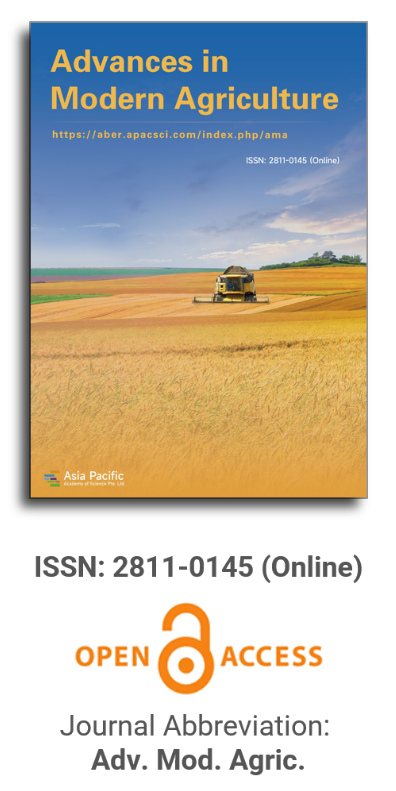


Weather based thumb rule models for formulating the crop insurance schemes for wheat in Punjab
Vol 5, Issue 1, 2024
VIEWS - 3362 (Abstract)
Download PDF
Abstract
The Wundanyi sub-catchment of Taita Hills is experiencing a high rate of deforestation due to the conversion of all its original forestland to agriculture and settlement during the last century. The landscape dynamics coupled with rainfall fluctuations in these critical ecosystems may significantly affect water resource distribution and food security in Taita Taveta County and its environs. This study aimed to establish the trends of selected hydroclimatic variables in the Wundanyi sub-catchment from 1970 to 2030 and their specific and combined effects on surface runoff and streamflow during the same period. The analysis was based on statistical trend analysis and dynamic landscape modeling using both historical and primary hydroclimatic data from Wundanyi and Voi weather stations. Results show highly variable mean seasonal and annual values of temperature, rainfall, runoff, and discharge in both Wundanyi and Voi weather stations. Increasing mean temperatures and rainfall were observed during the long dry season (JJAS) while decreasing seasonal discharges were observed during both the JJAS dry season and the OND short rainy season. These anomalies were pronounced in 1980–1981, 1986–1987, and 1992–1993, probably due to both global and local environmental changes affecting Taita Hills in general and the Wundanyi sub-catchment in particular. The predicted effects of rainfall fluctuation were supported by declining surface runoff of 1.3% during JJAS, and an increase of 0.8% during the OND, with similar effects on river discharges. The combined effects of climate variability and land use and cover changes (LUCC) on surface runoff were estimated to increase by 200 mm during JJAS and 370 mm during OND, while river discharges increased by 2.37 m3/s and 1.93 m3/s during JJAS and OND, respectively. Consequently, natural forest covers have significant control effects on surface runoff and can boost river discharges amid diverse agricultural cropping practices. Hence, crop diversification, agroforestry, and soil and water conservation structures are recommended to maintain effective control of LUCC on hydrological processes going on in the Wundanyi sub-catchment.
Keywords
References
- Kurukulasuriya P, Rosenthal S. Climate Change and Agriculture: A Review of impacts and adaptations. Available online: http://hdl.handle.net/10986/16616 (accessed on 8 March 2023).
- Zobeidi T, Yazdanpanah M, Bakhshi A. Climate change risk perception among agriculture students: the role of knowledge, environmental attitude, and belief in happening. J Agr Sci Tech. 2020; 22(1): 43-55.
- Sun Y. Enhanced Weather-Based Index Insurance Design for Hedging Crop Yield Risk. Frontiers in Plant Science. 2022; 13. doi: 10.3389/fpls.2022.895183
- Kumar PV, Rao VUM, Bhavani O, et al. Sensitive growth stages and temperature thresholds in wheat (Triticum aestivum L.) for index-based crop insurance in the Indo-Gangetic Plains of India. The Journal of Agricultural Science. 2015; 154(2): 321-333. doi: 10.1017/s0021859615000209
- Anonymous. Weather Based Agro Advisory Services. Available online: https://pib.gov.in/PressReleaseIframePage.aspx?PRID=1913976 (accessed on 8 March 2023).
- Nakka S, Jugulam M, Peterson D, et al. Herbicide resistance: Development of wheat production systems and current status of resistant weeds in wheat cropping systems. The Crop Journal. 2019; 7(6): 750-760. doi: 10.1016/j.cj.2019.09.004
- Akter N, Rafiqul Islam M. Heat stress effects and management in wheat. A review. Agronomy for Sustainable Development. 2017; 37(5). doi: 10.1007/s13593-017-0443-9
- Shiferaw B, Smale M, Braun HJ, et al. Crops that feed the world 10. Past successes and future challenges to the role played by wheat in global food security. Food Security. 2013; 5(3): 291-317. doi: 10.1007/s12571-013-0263-y
- Anonymous. India: wheat production volume in rabi season 2023. Available online: https://www.statista.com/statistics/1140239/india-production-volume-of wheat-during-rabi-season/ (accessed on 8 March 2023).
- Anonymous. Package of practice of Rabi crops. Punjab Agricultural University, Ludhiana. 2023. pp. 1-21.
- Ahmad Dar E, Brar AS, Dar SA, et al. Quantitative response of wheat to sowing dates and irrigation regimes using CERES-Wheat model. Saudi Journal of Biological Sciences. 2021; 28(11): 6198-6208. doi: 10.1016/j.sjbs.2021.06.074
- Chenu K, Porter JR, Martre P, et al. Contribution of Crop Models to Adaptation in Wheat. Trends in Plant Science. 2017; 22(6): 472-490. doi: 10.1016/j.tplants.2017.02.003
- Prabhjyot-Kaur, Singh H, Rao VUM, et al. Agrometeorology of wheat in Punjab state of India. Published online 2015. doi: 10.13140/RG.2.1.5105.6721
- Gahlot S, Lin TS, Jain AK, et al. Impact of environmental changes and land management practices on wheat production in India. Earth System Dynamics. 2020; 11(3): 641-652. doi: 10.5194/esd-11-641-2020
- Tyagi SK, Singh R, Krishnan P, et al. Variations in meteorological conditions resulted decline in wheat yield in North-West Indo-Gangetic plains. J Agric Physics. 2013; 13: 175-181.
- Rao BB, Chowdary PS, Sandeep VM, et al. Spatial analysis of the sensitivity of wheat yields to temperature in India. Agricultural and Forest Meteorology. 2015; 200: 192-202. doi: 10.1016/j.agrformet.2014.09.023
- Faghih H, Behmanesh J, Rezaie H, et al. Climate and rainfed wheat yield. Theoretical and Applied Climatology. 2021; 144(1-2): 13-24. doi: 10.1007/s00704-020-03478-9
- Lee BH, Kenkel P, Brorsen BW. Pre-harvest forecasting of county wheat yield and wheat quality using weather information. Agricultural and Forest Meteorology. 2013; 168: 26-35. doi: 10.1016/j.agrformet.2012.08.010
- Prabhjyot-Kaur, Sandhu SS, Singh S, et al. Climate Change- Punjab Scenario. Published online 2013. doi: 10.13140/RG.2.1.1368.4960
- Prabhjyot-Kaur, Sandhu SS, Dhir A. Mitigation and risk management of climate change in crop cultivation through the adoption of Agromet Advisory Bulletin (AAB) in NICRA adopted villages in Punjab. MAUSAM. 2023; 75(1): 249-256. doi: 10.54302/mausam.v75i1.6140
- Chattopadhyay N, Chandras S. Agrometeorological Advisory Services for Sustainable Development in Indian Agriculture. Biodiversity International Journal. 2018; 2(1). doi: 10.15406/bij.2018.02.00036
- Vashisth A, Singh R, Das D K, et al. Weather based agromet advisories for enhancing the production and income of the farmers under changing climate scenario Int J Agric Sci Food Technol. 2013; 4: 847-50.
- Kumar PV, Rao AVM, Chandran MA, et al. Micro-level Agromet advisory services using block level weather forecast—a new concept-based approach. Curr Sci. 2017; 112: 227–28.
- Vishnoi L, Kumar A, Kumar S, et al. Weather based crop insurance for risk management in agriculture. J Agrometeorol 2020; 22: 101-108. doi: 10.54386/jam.v22i2.149
- Aditya KS, Kishore A, Khan MD. Exploring farmers’ willingness to pay for crop insurance products: A case of weather-based crop insurance in Punjab, India. Agric Econ Res Rev. 2020; 33: 135-46.
- Bala A, Prabhjyot-Kaur. Formulation of weather based “Weekly Thumb Rule Models” for prediction of potential productivity of wheat in Punjab. Int J Agric Plant Sci. 2013; 1: 17-32.
- Gill KK, Sandhu SS, Divya, et al. Pre-harvest wheat yield prediction using CERES-wheat model for Ludhiana district, Punjab, India. Journal of Agrometeorology. 2018; 20(4): 319-321. doi: 10.54386/jam.v20i4.574
- Sandhu SS, Kaur P, Gill KK, et al. The effect of recent climate shifts on optimal sowing windows for wheat in Punjab, India. Journal of Water and Climate Change. 2019; 11(4): 1177-1190. doi: 10.2166/wcc.2019.241
- Sandhu SS, Prabhjyot-Kaur, Tripathu P, et al. Effect of intra-seasonal temperature on wheat at different locations of India: A study using CERES-Wheat model. Journal of Agrometeorology. 2016; 18(2): 222-233. doi: 10.54386/jam.v18i2.939
- Praveen KM, Kamath SKV, Ranjeetha K, et al. Analyzing the impact of weather based agro-advisory services of GKMS project among arecanut growers of Udupi district of Karnataka. J Pharm Innov. 2022; 11: 07-11.
- Kumar PV, Bal SK, Dhakar R, et al. Algorithms for weather-based management decisions in major rainfed crops of India: Validation using data from multi-location field experiments. Agron J. 2021; 113: 1816–1830. doi: 10.54386/jam.v20i4.574
- Dupdal R, Patil BL. Economic analysis of farmer’s awareness and perception about weather based crop insurance as tool of mitigation against climate variability in north Karnataka. International Journal of Commerce and Business Management. 2017; 10(2): 77-82. doi: 10.15740/has/ijcbm/10.2/77-82
- Dupdal R, Patil BL, Patil SL, et al. Weather based crop insurance scheme: opportunities and challenges. Int Res J Social Sci. 2020; 9: 56-59.
- Farooq M, Bramley H, Palta JA, et al. Heat Stress in Wheat during Reproductive and Grain-Filling Phases. Critical Reviews in Plant Sciences. 2011; 30(6): 491-507. doi: 10.1080/07352689.2011.615687
- Craufurd PQ, Vadez V, Jagadish SVK, et al. Crop science experiments designed to inform crop modeling. Agricultural and Forest Meteorology. 2013; 170: 8-18. doi: 10.1016/j.agrformet.2011.09.003
Supporting Agencies
Copyright (c) 2024 Sakshi Mahajan, Prabhjyot-Kaur, S. S. Sandhu
License URL: https://creativecommons.org/licenses/by/4.0/

This site is licensed under a Creative Commons Attribution 4.0 International License (CC BY 4.0).

Prof. Zhengjun Qiu
Zhejiang University, China

Cheng Sun
Academician of World Academy of Productivity Science; Executive Chairman, World Confederation of Productivity Science China Chapter, China
Indexing & Archiving
In the realm of modern agriculture, the integration of cutting-edge technologies is revolutionizing the way we approach sustainable farming practices. A recent study published in Advances in Modern Agriculture titled "Classification of cotton water stress using convolutional neural networks and UAV-based RGB imagery" has garnered significant attention for its innovative approach to precision irrigation management. Conducted by researchers from Institute of Data Science and the AgriLife Research and Extension Center of Texas A&M University (authors's information is below). This study introduces a novel method for classifying cotton water stress using unmanned aerial vehicles (UAVs) and convolutional neural networks (CNNs), offering a powerful solution for optimizing water use in agriculture.
Modern agricultural technology is evolving rapidly, with scientists collaborating with leading agricultural enterprises to develop intelligent management practices. These practices utilize advanced systems that provide tailored fertilization and treatment options for large-scale land management.
This journal values human initiative and intelligence, and the employment of AI technologies to write papers that replace the human mind is expressly prohibited. When there is a suspicious submission that uses AI tools to quickly piece together and generate research results, the editorial board of the journal will reject the article, and all journals under the publisher's umbrella will prohibit all authors from submitting their articles.
Readers and authors are asked to exercise caution and strictly adhere to the journal's policy regarding the usage of Artificial Intelligence Generated Content (AIGC) tools.
Asia Pacific Academy of Science Pte. Ltd. (APACSCI) specializes in international journal publishing. APACSCI adopts the open access publishing model and provides an important communication bridge for academic groups whose interest fields include engineering, technology, medicine, computer, mathematics, agriculture and forestry, and environment.



.jpg)
.jpg)

.jpg)
